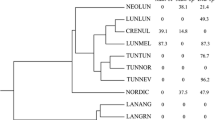Abstract
Three species of Collinsia (commonly called Blue-eyed Mary, Innocence, Chinese Houses) including 12 populations of C. verna were examined for genetic variability and differentiation using three investigative techniques: enzyme electrophoresis, chiasma frequencies, and morphological measurements. Analysis of isozyme data showed higher heterozygosity was maintained in the C. verna populations (previously reported to be self pollinating) than in C. heterophylla and C. tinctoria, which are outcrossers. C. heterophylla and C. tinctoria were separated by a significant genetic distance from each other and especially from C. verna. Within C. verna isozyme, morphological, and chiasma frequency analyses separated the populations into subsets showing some geographical trends, possibly influenced by water dispersal of seeds. High genetic variability was maintained and differentiation has occured in the C. verna populations. The explanation may lie in a combination of factors associated with the ‘heterozygosity paradox’ including microgeographical influence and inappropriate mating system classification.
Similar content being viewed by others
References
Allard, R. W., S. K. Jain and P. L. Workman. 1968. The genetics of inbreeding populations. Adv. Genet. 14: 55–131.
Antonovics, J., A. D. Bradshaw & R. G. Turner. 1971. Heavy metal tolerance in plants, Adv. ecol. Res. 7: 1–85.
Aston, J. L. & A. D. Bradshaw. 1966. Evolution in closely adjacent plant populations. II. Agrostis stolonifera in maritime habitats. Heredity 21: 649–664.
Brown, A. H. D. 1979. Enzyme polymorphism in plant populations. Theor. Pop. Biol. 15: 1–42.
Clegg, M. T. & R. W. Allard. 1972. Patterns of genetic differentiation in the slender wild oat species Avena barbata. Proc. natn. Acad. Sci. U.S.A. 69: 1820–1824.
Garber, E. D. 1956. The genus Collinsia. I. Chromosome number and chiasma frequency of species in the two sections. Bot. Gaz. 118(1): 71–73.
Garber, E. D. 1958. The genus Collinsia. III. The significance of chiasmata frequencies as a cytotaxonomic tool. Madrono 14(5): 172–176.
Garber, E. D. 1975. Collinsia. In: R. C. King (Ed.), Handbook of Genetics, Vol. 2. Plenum Press, New York.
Gottlieb, L. D. 1981. Electrophoretic evidence and plant populations. Progress in Phytochemistry. 7: 1–46.
Hamrick, J. L. & R. W. Allard. 1972. Microgeographical variation in allozyme frequencies in Avena barbata. Proc. natn. Acad. Sci. U.S.A. 69: 2100–2104.
Hamrick, J. L., V. B. Linhart & J. B. Mitton. 1979. Relationships between life history characteristics and electrophoretically detectable genetic variation in plants. A.Rev.Ecol. Syst. 10: 173–200.
Harris, H. & D. A. Hopkinson. 1976. Handbook of enzyme electrophoresis in human genetics. North Holland Publishing Co., Amsterdam.
Jain, S. K. 1979. Adaptive strategies: Polymorphism plasticity and homeostasis. In: 00 Solbrig et al. (Eds) Topics in plant population biology. Columbia University Press. New York.
Jain, S. K. & A. D. Bradshaw. 1966. Evolutionary divergence among adjacent plant populations. I. The evidence and its theoretical analysis. Heredity 21: 407–441.
Levin, D. A. 1976. Consequences of long term artificial selection, inbreeding and isolation in Phlox. II. The organization of allozymic variability. Evolution 30: 463–472.
Linhart, Y. B. 1974. Intra-population differentiation in annual plants. I. Veronica perigrina L. raised under noncompetitive conditions. Evolution 28: 232–243.
Marshall, D. R. & R. W. Allard. 1970. Maintenance of isozyme polymorphisms in natural populations of Avena barbata. Genetics 66: 393–399.
Rickett, w. H. (Ed.) 1966. Wildflowers of the United States Vol. 1 Part 2. McGraw Hill Book Col. New York 401–402.
Selander, R. K., M. H. Smith, S. Y. Yang, W. E. Johnson & J. B. Gestner. 1971. Biochemical polymorphism and systematics in the genus Peromyseus. I. Variation in the oldfield mouse. Studies in Genetics VI. Univ. of Texas Publ. 7103: 49–90.
Shaw, C. R. & R. P. Prassad. 1970. Starch gel electrophoresis of enzymes. A compilation of recipes. Biochem. Genet. 197–320.
Snaydon, R. W. & M. S. Davies. 1972. Rapid population differentiation in mosaic environment. II. Morphological variation in Anthoxanthum odoratum. Evolution 26: 390–405.
Solbrig, O. T. 1972. Breeding system and genetic variation in Leavenworthia. Evolution 26: 155–160.
Soltis, D. E. 1982. Allozymic variability in Sullvantia (Saxifragaceac) Syst. Bot. 7(1): 26–34.
Soulé, M. 1976. Allozyme variation. Its determinants in space and time. In: F. G. Ayala (Ed.), Molecular evolution. Sinauer, Sunderland.
Swofford, D. L. & R. B. Selander, 1981. Biosys-1: A FORTRAN program for the comprehensive analysis of electrophoretic data in population genetics and systematics. J. Heredity 72: 281–283.
Author information
Authors and Affiliations
Rights and permissions
About this article
Cite this article
Greenlee, J.K., Rai, K.S. Population differentiation in Collinsia verna Nuttal (Scrophulariaceae): a multifaceted approach. Genetica 71, 51–61 (1986). https://doi.org/10.1007/BF00123233
Received:
Accepted:
Issue Date:
DOI: https://doi.org/10.1007/BF00123233




